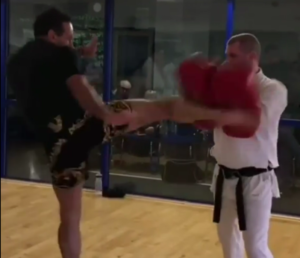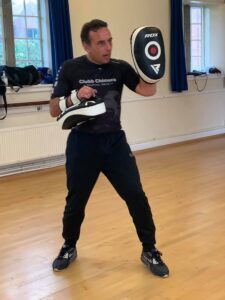Focus Mitt Training (diary entry)
- jamie03066
- Aug 23, 2021
- 3 min read



22.08.21 Sunday's first class was small group teacher training on the subject of developing effective pad-work drills. We primarily used boxing focus mitts but also Thai pads towards the end of the session. After a warm-up we looked at the criteria for pad-holding, went through basic combination work and also different types of focus mitt work. Pad-Holding - This is not as universal as just about every coach would have you believe. A lot of it is dependent on the drill being taught and the context of the training. However, a very good basic habit is to hold the mitts as close together as possible and as near to the area on the body the fighter needs to target as possible. Pads need to be held firmly with plenty of "weight". In self-defence training I usually opt for a firm, steady hold as the coach should be encouraging the fighter to exert constant, uninterupted forward pressure. However, when it comes to all forms of consensual fighting, coaches like to "meet" punches by moving about 5% forward from the target zone. Bad form includes holding pads too lightly, far off from the body and meeting too early with the striker. The first and the third bad form issue can cause injuries to the fighter whereas the second one just teaches unrealistic targeting. Coaching - I teach that a coach should never work as hard as the fighter, but some forms of training should mean that they are not too far behind in their physical exertions. Coaches should encourage correct breathing. It is also the coach's job to create the synopsis for the "fight" they are replicating on the focus mitts. Pads should never be held up constantly. This is the job of a heavy bag or any other form solo training equipment. Combination Work - We began with some simple combination work, not going more than four punches at a time. However, I introduced slipping and rolling too. The combinations were called out as is the norm in these combinations, using a standard numbering system: 1 = jab 2 = straight right (left)/cross 3 = lead hook 4 = rear hook 5 = lead uppercut 6 = rear uppercut 7 = liver shot 8 = overhand right (left) We did not go into details over different ranges or variations on the above punches, but I discussed using the rear side with some combinations and we also covered the body jab. For Muay Thai/Kickboxing build-ons I went through four simple combinations: 1/rear round kick, 1-2/switch-kick, 1-2-3/rear round kick and 1-2-3-8/switch-kick I also went through the ways to hold Thai pads for elbows, knees and kicks. This included keeping a pad up after a punch had been thrown to signal throwing an elbow. We also went through the main elbow strikes - horizontal, slashing, spear, smash down, spinning, side, diagonal, chop and flying. Whilst holding for round kicks we looked at ensuring the pads were held flush rather than at an angle. My first Muay Thai kru always taught a cross-pads hold for the knee strike rather than just keeping the same teep hold. When holding for a round kick to the led it is important to keep the holding hand flat against the leg. Flow Pad Drilling - We looked at flow work. Not to be confused with set combination work designed to promote rhythm and flow, flow work on the focus mitts, shadow boxing or heavy bag are continuous punching, slipping, blocking and parrying drilling. This promotes good tactile awareness and keeps the fighter adapting and changing. Strikes are delivered in a touch contact fashion. Proactive Feedback Loop Training - This is a form of training that combines mirror footwork with flash-pad work and defence testing to create an exercise as close to a sparring or pressure-testing environment as possible. The feedback loop part comes into play when the fighter then spars and then returns to the focus mitt work, carrying over the experience. This training is also a beneficial exercise for the coach (who is usually a fellow training partner in this context). https://clubbchimera.com/services/









